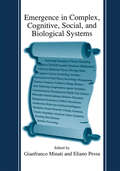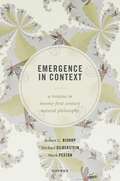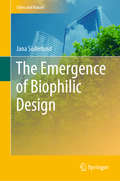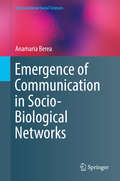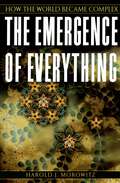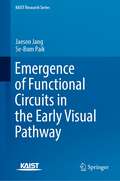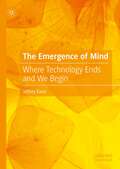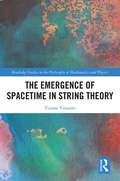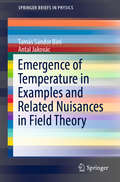- Table View
- List View
Emergence and Modularity in Life Sciences
by Lars H. Wegner Ulrich LüttgeThis book focuses on modules and emergence with self-organization in the life sciences. As Aristotle observed so long ago, the whole is more than the sum of its parts. However, contemporary science is dominated by reductionist concepts and tends to neglect the non-reproducible features of complex systems, which emerge from the interaction of the smaller units they are composed of. The book is divided into three major parts; the essays in part A highlight the conceptual basis of emergence, linking it to the philosophy of science, systems biology and sustainability. This is subsequently exemplified in part B by applying the concept of emergence to various biological disciplines, such as genetics, developmental biology, neurobiology, plant physiology and ecology. New aspects of emergence come into play when biology meets the technical sciences, as revealed in a chapter on bionics. In turn, part C adopts a broader view, revealing how the organization of life follows a hierarchical order in terms of scalar dimensions, ranging from the molecular level to the entire biosphere. The idea that life is primarily and exclusively shaped by processes at the molecular level (and, in particular, by the information encoded in the genome) is refuted; rather, there is no hierarchy with respect to the level of causation in the cross-talk between the levels. In the last two chapters, the evolutionary trend toward ever-increasing complexity in living systems is interpreted in terms of the Gaia hypothesis sensu Lovelock: the entire biosphere is viewed as a functional unit (or ‘holobiont-like system’) organized to develop and sustain life on Earth.
An Emergence Approach to Speech Acquisition: Doing and Knowing
by Barbara L. Davis Lisa M. BedoreThe central assertion in this volume is that the young child uses general skills, scaffolded by adults, to acquire the complex knowledge of sound patterns and the goal-directed behaviors for communicating ideas through language and producing speech. A child’s acquisition of phonology is seen as a product of her physical and social interaction capacities supported by input from adult models about ambient language sound patterns. Acquisition of phonological knowledge and behavior is a product of this function-oriented complex system. No pre-existing mental knowledge base is necessary for acquiring phonology in this view. Importantly, the child’s diverse abilities are used for many other functions as well as phonological acquisition. Throughout, an evaluation is made of the research on patterns of typical development across languages in monolingual and bilingual children and children with speech impairments affecting various aspects of their developing complex system. Also considered is the status of available theoretical perspectives on phonological acquisition relative to an emergence proposal, and contributions that this perspective could make to more comprehensive modeling of the nature of phonological acquisition are proposed. The volume will be of interest to cognitive psychologists, linguistics, and speech pathologists.
An Emergence Approach to Speech Acquisition: Doing and Knowing
by Barbara L. Davis Lisa M. BedoreThe central assertion in this volume is that the young child uses general skills, scaffolded by adults, to acquire the complex knowledge of sound patterns and the goal-directed behaviors for communicating ideas through language and producing speech. A child’s acquisition of phonology is seen as a product of her physical and social interaction capacities supported by input from adult models about ambient language sound patterns. Acquisition of phonological knowledge and behavior is a product of this function-oriented complex system. No pre-existing mental knowledge base is necessary for acquiring phonology in this view. Importantly, the child’s diverse abilities are used for many other functions as well as phonological acquisition. Throughout, an evaluation is made of the research on patterns of typical development across languages in monolingual and bilingual children and children with speech impairments affecting various aspects of their developing complex system. Also considered is the status of available theoretical perspectives on phonological acquisition relative to an emergence proposal, and contributions that this perspective could make to more comprehensive modeling of the nature of phonological acquisition are proposed. The volume will be of interest to cognitive psychologists, linguistics, and speech pathologists.
Emergence, Entanglement, and Political Economy (Studies in Public Choice #38)
by David J. Hebert Diana W. ThomasThis volume is intended to serve as a review of the “next generation” of political economy scholars in what can be called the “Wagnerian” tradition, which traces its roots to Buchanan and De Viti De Marco in the 1930s, who argued that any decision that results from a political entity must be the product of individual decision makers operating within some framework of formal and informal rules. To treat these decisions as if they were the product of one single mind, or even simply the additive result of several decisions, is to fundamentally misunderstand and mischaracterize the dynamics of collective action. Today, Richard Wagner is among the most prominent theorists in analyzing the institutional foundations of the economy and the organization of political decision-making. In this collection of original essays, former students schooled in this tradition offer emerging insights on public choice theory, public finance, and political economy, across a range of topics from voting behavior to entrepreneurship.
Emergence in Complex, Cognitive, Social, and Biological Systems
by Gianfranco Minati Eliano PessaThe systems movement is made up of many systems societies as well as of disciplinary researchers and researches, explicitly or implicitly focusing on the subject of systemics, officially introduced in the scientific community fifty years ago. Many researches in different fields have been and continue to be sources of new ideas and challenges for the systems community. To this regard, a very important topic is the one of EMERGENCE. Between the goals for the actual and future systems scientists there is certainly the definition of a general theory of emergence and the building of a general model of it. The Italian Systems Society, Associazione Italiana per la Ricerca sui Sistemi (AIRS), decided to devote its Second National Conference to this subject. Because AIRS is organized under the form of a network of researchers, institutions, scholars, professionals, and teachers, its research activity has an impact at different levels and in different ways. Thus the topic of emergence was not only the focus of this conference but it is actually the main subject of many AIRS activities.
Emergence in Condensed Matter and Quantum Gravity: A Nontechnical Review (SpringerBriefs in Physics)
by George MusserThis book surveys the science at a semipopular, Scientific American-level. It is even-handed with regard to competing directions of research and philosophical positions. It is hard to get even two people to agree on anything, yet a million billion water molecules can suddenly and abruptly coordinate to lock themselves into an ice crystal or liberate one another to billow outwards as steam. The marvelous self-organizing capacity of matter is one of the central and deepest puzzles of physics, with implications for all the natural sciences. Physicists in the past century have found a remarkable diversity of phases of matter—and equally remarkable commonalities within that diversity. The pace of discovery has, if anything, only quickened in recent years with the appreciation of quantum phases of matter and so-called topological order. The study of seemingly humdrum materials has made contact with the more exotic realm of quantum gravity, as theorists realize that the spacetime continuum may itself be a phase of some deeper and still unknown constituents. These developments flesh out the sometimes vague concept of the emergence—how exactly it is that complexity begets simplicity.
Emergence in Context: A Treatise in Twenty-First Century Natural Philosophy
by Robert C. Bishop Michael Silberstein Mark PextonScience, philosophy of science, and metaphysics have long been concerned with the question of how order, stability, and novelty are possible and how they happen. How can order come out of disorder? This book introduces a new account, contextual emergence, seeking to answer these questions. The authors offer an alternative picture of the world with an alternative account of how novelty and order arise, and how both are possible. Contextual emergence is grounded primarily in the sciences as opposed to logic or metaphysics. It is both an explanatory and ontological account of emergence that gets beyond the impasse between “weak” and “strong” emergence in the emergence debates. It challenges the “foundationalist” or hierarchical picture of reality and emphasizes the ontological and explanatory fundamentality of multiscale stability conditions and their contextual constraints, often operating globally over interconnected, interdependent, and interacting entities and their multiscale relations. It also focuses on the conditions that make the existence, stability, and persistence of emergent systems and their states and observables possible. These conditions and constraints are irreducibly multiscale relations, so it is not surprising that scientific explanation is often multiscale. Such multiscale conditions act as gatekeepers for systems to access modal possibilities (e.g., reducing or enhancing a system's degrees of freedom). Using examples from across the sciences, ranging from physics to biology to neuroscience and beyond, this book demonstrates that there is an empirically well-grounded, viable alternative to ontological reductionism coupled with explanatory anti-reductionism (weak emergence) and ontological disunity coupled with the impossibility of robust scientific explanation (strong emergence). Central metaphysics of science concerns are also addressed. Emergence in Context: A Treatise in Twenty-First Century Natural Philosophy is written primarily for philosophers of science, but also professional scientists from multiple disciplines who are interested in emergence and particularly in the metaphysics of science.
The Emergence of Astrophysics in Asia: Opening a New Window on the Universe (Historical & Cultural Astronomy)
by Tsuko Nakamura Wayne OrchistonThis book examines the ways in which attitudes toward astronomy in Australia, China, India, Indonesia, Japan, South Korea, New Zealand, Taiwan, Thailand and Uzbekistan have changed with the times.The emergence of astrophysics was a worldwide phenomenon during the late nineteenth and early twentieth centuries, and it gradually replaced the older-style positional astronomy, which focused on locating and measuring the movements of the planets, stars, etc.. Here you will find national overviews that are at times followed by case studies of individual notable achievements. Although the emphasis is on the developments that occurred around 1900, later pioneering efforts in Australian, Chinese, Indian and Japanese radio astronomy are also included. As the first book ever published on the early development of astrophysics in Asia, the authors fill a chronological and technological void. Though others have already written about earlier astronomical developments in Asia, and about the recent history of astronomy in various Asian nations, no one has examined the emergence of astrophysics, the so-called ‘new astronomy’ in Asia during the late nineteenth and early twentieth centuries.
The Emergence of Biophilic Design (Cities and Nature)
by Jana SöderlundThis book addresses the emergence of biophilic design, a form of design that looks at people’s intrinsic connection with nature. There is no denying that biophilic design is rapidly expanding globally as an effective response to pressing issues in urban areas and built environments. From being a term few had heard of in 2012, when the author’s research began, to one that is currently trending in a broad range of disciplines, the story of its emergence has never been properly told. The story of the emergence of biophilic design is the story of a social movement and how a gathering of people with a common interest and passion can spark a global trend. The book and the stories within are not only engaging but also informative and educational, offering readers an in-depth understanding of what biophilic design is all about, and how to promote its implementation in their own built environment. Hopefully, they will inspire people to act, to campaign and to implement initiatives in their urban environment, with the confidence that they are capable of making a difference. The author spent three years researching the emergence of biophilic design, and why and how it was driven by certain people who championed the concept. Part of the author’s research involved a three-month tour of ten North American cities, during which she interviewed 26 key players. These people ranged from community leaders, landscape architects, and academics, to the CEOs of NGOs and government leaders. The result is a collection of stories that illustrate the evolution of biophilic design, and how it was frequently born from a passion for, belief in and love of nature, as well as a response to an urban crisis.
Emergence of Communication in Socio-Biological Networks (Computational Social Sciences)
by Anamaria BereaThis book integrates current advances in biology, economics of information and linguistics research through applications using agent-based modeling and social network analysis to develop scenarios of communication and language emergence in the social aspects of biological communications. The book presents a model of communication emergence that can be applied both to human and non-human living organism networks. The model is based on economic concepts and individual behavior fundamental for the study of trust and reputation networks in social science, particularly in economics; it is also based on the theory of the emergence of norms and historical path dependence that has been influential in institutional economics. Also included are mathematical models and code for agent-based models to explore various scenarios of language evolution, as well as a computer application that explores language and communication in biological versus social organisms, and the emergence of various meanings and grammars in human networks.Emergence of Communication in Socio-Biological Networks offers both a completely novel approach to communication emergence and language evolution and provides a path for the reader to explore various scenarios of language and communication that are not constrained to the human networks alone. By illustrating how computational social science and the complex systems approach can incorporate multiple disciplines and offer an integrated theory-model approach to the evolution of language, the book will be of interest to researchers working with computational linguistics, mathematical linguistics, and complex systems.
The Emergence of EU Defense Research Policy: From Innovation to Militarization (Innovation, Technology, and Knowledge Management)
by Nikolaos Karampekios Iraklis Oikonomou Elias G. CarayannisThis book explores European security and defense R&D policy, unveiling the strategic, industrial, institutional and ideational sources of the European Commission’s military research initiative. Starting from a well-defined empirical epicentre—the rise of non-civilian R&D priorities in the European Union—this book covers interrelated themes and topics such as approaches to arms production and R&D collaboration relationships between European R&D-related institutions technology and research foundations of European security policy past and present European armament collaborations transatlantic R&D collaboration the militarization of border security. Divided into 5 sections, the enclosed chapters explore the EU technology and innovation policy in regards to security, industrial competitiveness and military capabilities. The terrorist attacks in the US on September 11, 2001 provided a window of opportunity for the introduction of security as a distinct European R&D priority. In fact, since 2002, the Preparatory Action for Security Research (PASR) has funded 45 million euros to 39 research consortia to conduct security R&D. While the idea of pooling defense research efforts and programmes in Europe is not new, the establishment of institutions like the European Defense Agency (EDA) are a major step into institutionalizing European agencies involvement in supporting defense technology research. It is against this backdrop of policy developments that this book is positioned, in addition to addressing some of the political, economic, industrial and philosophical questions that arise. Featuring contributions from a variety of academic fields and industries, this book will be of interest to scholars, researchers, students and policy makers in the fields of security policy, international relations, innovation, European studies and military studies.
The Emergence of Everything: How the World Became Complex
by Harold J. MorowitzWhen the whole is greater than the sum of the parts--indeed, so great that the sum far transcends the parts and represents something utterly new and different--we call that phenomenon emergence. When the chemicals diffusing in the primordial waters came together to form the first living cell, that was emergence. When the activities of the neurons in the brain result in mind, that too is emergence. In The Emergence of Everything, one of the leading scientists involved in the study of complexity, Harold J. Morowitz, takes us on a sweeping tour of the universe, a tour with 28 stops, each one highlighting a particularly important moment of emergence. For instance, Morowitz illuminates the emergence of the stars, the birth of the elements and of the periodic table, and the appearance of solar systems and planets. We look at the emergence of living cells, animals, vertebrates, reptiles, and mammals, leading to the great apes and the appearance of humanity. He also examines tool making, the evolution of language, the invention of agriculture and technology, and the birth of cities. And as he offers these insights into the evolutionary unfolding of our universe, our solar system, and life itself, Morowitz also seeks out the nature of God in the emergent universe, the God posited by Spinoza, Bruno, and Einstein, a God Morowitz argues we can know through a study of the laws of nature. Written by one of our wisest scientists, The Emergence of Everything offers a fascinating new way to look at the universe and the natural world, and it makes an important contribution to the dialogue between science and religion.
The Emergence of Everything: How the World Became Complex
by Harold J. MorowitzWhen the whole is greater than the sum of the parts--indeed, so great that the sum far transcends the parts and represents something utterly new and different--we call that phenomenon emergence. When the chemicals diffusing in the primordial waters came together to form the first living cell, that was emergence. When the activities of the neurons in the brain result in mind, that too is emergence. In The Emergence of Everything, one of the leading scientists involved in the study of complexity, Harold J. Morowitz, takes us on a sweeping tour of the universe, a tour with 28 stops, each one highlighting a particularly important moment of emergence. For instance, Morowitz illuminates the emergence of the stars, the birth of the elements and of the periodic table, and the appearance of solar systems and planets. We look at the emergence of living cells, animals, vertebrates, reptiles, and mammals, leading to the great apes and the appearance of humanity. He also examines tool making, the evolution of language, the invention of agriculture and technology, and the birth of cities. And as he offers these insights into the evolutionary unfolding of our universe, our solar system, and life itself, Morowitz also seeks out the nature of God in the emergent universe, the God posited by Spinoza, Bruno, and Einstein, a God Morowitz argues we can know through a study of the laws of nature. Written by one of our wisest scientists, The Emergence of Everything offers a fascinating new way to look at the universe and the natural world, and it makes an important contribution to the dialogue between science and religion.
Emergence of Functional Circuits in the Early Visual Pathway (KAIST Research Series)
by Jaeson Jang Se-Bum PaikThis book discusses the emergence of diverse functional organizations in the visual pathway which could be spontaneously and solely initiated by the random feedforward wiring of neural circuits. It demonstrates that the structure of ON and OFF retinal ganglion cell (RGC) mosaics is projected onto V1 by retino-cortical feedforward mapping to induce higher cognitive functions. This book will be beneficial for both theoretical and experimental neuroscientists, as well as for researchers using brain-inspired neural network models.
Emergence of In Vitro 3D Systems to Model Human Malaria
by Kasem KulkeawThis book illustrates the importance and advances of the disease model for malaria, a globally affected public health problem. This book provides comprehensive information on the malaria biology in a liver and all in vitro platforms for liver-stage malaria, including principles, protocols, applications for disease modeling and drug screening, and their limitations. The initial chapter describes the basis of stem cells in liver generation during development and in adults. The subsequent chapters highlight recent and emerging advances in liver organoid and liver-on-a-chip in modeling malaria. The book presents current protocols and methods to generate liver organoid and liver-on-a-chip together with their advantages and limitations. Toward the end, the book examines the humanized mouse model of liver-stage malaria using ectopic artificial livers regarding novel readout modalities. The recent advancement and challenges in combining liver-on-a-chip technology with biosensors are highlighted for assessing hepatocyte development viability and functions. The book elucidates the potential of these 3D models to understand the biological complexity of cellular and molecular mechanisms involved in Plasmodium development in the liver, toolboxes to investigate parasite deployment in the 3D models, and to implement in drug discovery. Finally, the book discusses the future directions and challenges in the applications of liver organoids and liver on-chip in the biology of live-stage malaria. This book is helpful for researchers and scientists in the field of parasitology, cell biology, tissue engineering, and pharmacology.
The Emergence of Indigenous Peoples (SpringerBriefs on Pioneers in Science and Practice #3)
by Rodolfo StavenhagenThis is the second part of a trilogy published in the Springer Briefs on Pioneers in Science and Practice on the occasion of the 80th birthday of Rodolfo Stavenhagen, a distinguished Mexican sociologist and professor emeritus of El Colegio de Mexico. Rodolfo Stavenhagen wrote this collection of six essays on The Emergence of Indigenous Peoples between 1965 and 2009. These widely discussed classic texts address: Classes, Colonialism and Acculturation (1965); Indigenous Peoples: An Introduction (2009); The Return of the Native: The Indigenous Challenge in Latin America (2002); Indigenous Peoples in Comparative Perspective (2004); Mexico’s Unfinished Symphony: The Zapatista Movement (2000); and Struggle and Resistance: Mexico’s Indians in Transition (2006). This volume discusses the emergence of indigenous peoples as new social and political actors at the national and international level. These texts deal with human rights, especially during the years he the author served as United Nations special rapporteur on the rights of indigenous peoples.
The Emergence of Mind: Where Technology Ends and We Begin
by Jeffrey KaneWhile it may appear that generative AI has mastered the mystery of the human mind and released its full power, The Emergence of Mind: Where Technology Ends and We Begin demonstrates the profound and fundamental limitations of the technology and its use as a model of human thinking. In response, the book offers an emergent model of the human mind rooted in our experiences as living, sentient, social and conscious beings. The text explores the nature of meaning in human cognition and the critical importance of the experience of ideas. In so doing, it offers insights into the cultivation of specific generative capacities of the human mind.
The Emergence of Ornithology as a Scientific Discipline: 1760–1850 (Studies in the History of Modern Science #12)
by Paul FarberA number of years ago I began a project to derme and evaluate the impact of Buffon's Histoire naturelle on the science of the late eighteenth and early nineteenth centuries. My attention, however, was soon diverted by the striking difference between the highly literary natural history of Buffon and the duller, but more rigor ous, zoology of his successors, and I began to try to understand this transformation of natural history into a set of separate scientific disciplines (geology, botany, ornithology, entomology, ichthyology, etc. ). Historical literature on the emergence of the biological sciences in the early nineteenth century is, unfortunately, scant. ! Indeed the entire issue of the emergence of scientific disciplines in general is poorly documented. A recent collection of articles on the subject states: One reason for this is, of course, that scientific development is a highly com plex process. Consequently, there has been a tendency for those engaged in its empirical study to select for close attention one strand or a small number of strands from the complicated web of social and intellectual factors at work. Many historians, for example, have dealt primarily with the internal development of scientific knowledge within given fields of inquiry. Sociologists, in contrast, have tended to concentrate on the social processes associated with the activities of scientists; but at the same time 2 they have largely ignored the intellectual content of science.
The Emergence of Personal Data Protection as a Fundamental Right of the EU (Law, Governance and Technology Series #16)
by Gloria González FusterThis book explores the coming into being in European Union (EU) law of the fundamental right to personal data protection. Approaching legal evolution through the lens of law as text, it unearths the steps that led to the emergence of this new right. It throws light on the right’s significance, and reveals the intricacies of its relationship with privacy.The right to personal data protection is now officially recognised as an EU fundamental right. As such, it is expected to play a critical role in the future European personal data protection legal landscape, seemingly displacing the right to privacy. This volume is based on the premise that an accurate understanding of the right’s emergence is crucial to ensure its correct interpretation and development.Key questions addressed include: How did the new right surface in EU law? How could the EU Charter of Fundamental Rights claim to render ‘more visible’ an invisible right? And how did EU law allow for the creation of a new right while ensuring consistency with existing legal instruments and case law?The book first investigates the roots of personal data protection, studying the redefinition of privacy in the United States in the 1960s, as well as pioneering developments in European countries and in international organisations. It then analyses the EU’s involvement since the 1970s up to the introduction of legislative proposals in 2012. It grants particular attention to changes triggered in law by language and, specifically, by the coexistence of languages and legal systems that determine meaning in EU law. Embracing simultaneously EU law’s multilingualism and the challenging notion of the untranslatability of words, this work opens up an inspiring way of understanding legal change.This book will appeal to legal scholars, policy makers, legal practitioners, privacy and personal data protection activists, and philosophers of law, as well as, more generally, anyone interested in how law works.
The Emergence of Religion in Human Evolution (Routledge Studies in Neurotheology, Cognitive Science and Religion)
by Margaret Boone Rappaport Christopher J. CorballyReligious capacity is a highly elaborate, neurocognitive human trait that has a solid evolutionary foundation. This book uses a multidisciplinary approach to describe millions of years of biological innovations that eventually give rise to the modern trait and its varied expression in humanity’s many religions. The authors present a scientific model and a central thesis that the brain organs, networks, and capacities that allowed humans to survive physically also gave our species the ability to create theologies, find sustenance in religious practice, and use religion to support the social group. Yet, the trait of religious capacity remains non-obligatory, like reading and mathematics. The individual can choose not to use it. The approach relies on research findings in nine disciplines, including the work of countless neuroscientists, paleoneurologists, archaeologists, cognitive scientists, and psychologists. This is a cutting-edge examination of the evolutionary origins of humanity’s interaction with the supernatural. It will be of keen interest to academics working in Religious Studies, Neuroscience, Cognitive Science, Anthropology, Evolutionary Biology, and Psychology.
The Emergence of Religion in Human Evolution (Routledge Studies in Neurotheology, Cognitive Science and Religion)
by Margaret Boone Rappaport Christopher J. CorballyReligious capacity is a highly elaborate, neurocognitive human trait that has a solid evolutionary foundation. This book uses a multidisciplinary approach to describe millions of years of biological innovations that eventually give rise to the modern trait and its varied expression in humanity’s many religions. The authors present a scientific model and a central thesis that the brain organs, networks, and capacities that allowed humans to survive physically also gave our species the ability to create theologies, find sustenance in religious practice, and use religion to support the social group. Yet, the trait of religious capacity remains non-obligatory, like reading and mathematics. The individual can choose not to use it. The approach relies on research findings in nine disciplines, including the work of countless neuroscientists, paleoneurologists, archaeologists, cognitive scientists, and psychologists. This is a cutting-edge examination of the evolutionary origins of humanity’s interaction with the supernatural. It will be of keen interest to academics working in Religious Studies, Neuroscience, Cognitive Science, Anthropology, Evolutionary Biology, and Psychology.
The Emergence of Somatic Psychology and Bodymind Therapy (Critical Theory and Practice in Psychology and the Human Sciences)
by B. BarrattSomatic psychology and bodymind therapy (the simultaneous study of the mind and body) are challenging contemporary understandings of the psyche, of what it means to be human and how to heal human suffering.
The Emergence of Spacetime in String Theory (Routledge Studies in the Philosophy of Mathematics and Physics)
by Tiziana VistariniThe nature of space and time is one of the most fascinating and fundamental philosophical issues which presently engages at the deepest level with physics. During the last thirty years this notion has been object of an intense critical review in the light of new scientific theories which try to combine the principles of both general relativity and quantum theory—called theories of quantum gravity. This book considers the way string theory shapes its own account of spacetime disappearance from the fundamental level.
The Emergence of Spacetime in String Theory (Routledge Studies In The Philosophy Of Mathematics And Physics Ser.)
by Tiziana VistariniThe nature of space and time is one of the most fascinating and fundamental philosophical issues which presently engages at the deepest level with physics. During the last 30 years, this notion has been object of an intense critical review in the light of new scientific theories which try to combine the principles of both general relativity and quantum theory – called theories of quantum gravity. This book considers the way string theory shapes its own account of spacetime disappearance from the fundamental level. Tiziana Vistarini is a Lecturer in the Department of Philosophy at the University of Colorado Boulder.
Emergence of Temperature in Examples and Related Nuisances in Field Theory (SpringerBriefs in Physics)
by Antal Jakovác Tamás Sándor BiróField theory, relying on the concept of continuous space and time while confronted with the quantum physical nature of observable quantities, still has some fundamental challenges to face. One such challenge is to understand the emergence of complexity in the behavior of interacting elementary fields, including among other things nontrivial phase structures of elementary matter at high energy density or an atypical emergence of statistical properties, e.g., when an apparent temperature is proportional to a constant acceleration in a homogeneous gravitational field. Most modern textbooks on thermal field theory are mainly concerned with how the field theory formalism should be used if a finite temperature is given. In contrast, this short primer explores how the phenomenon of temperature emerges physically for elementary fields - inquiring about the underlying kinetic field theory and the way energy fluctuations and other noise should be handled - and it investigates whether and how this harmonizes with traditional field theory concepts like spectral evolution, the Keldysh formalism, and phase transitions.



